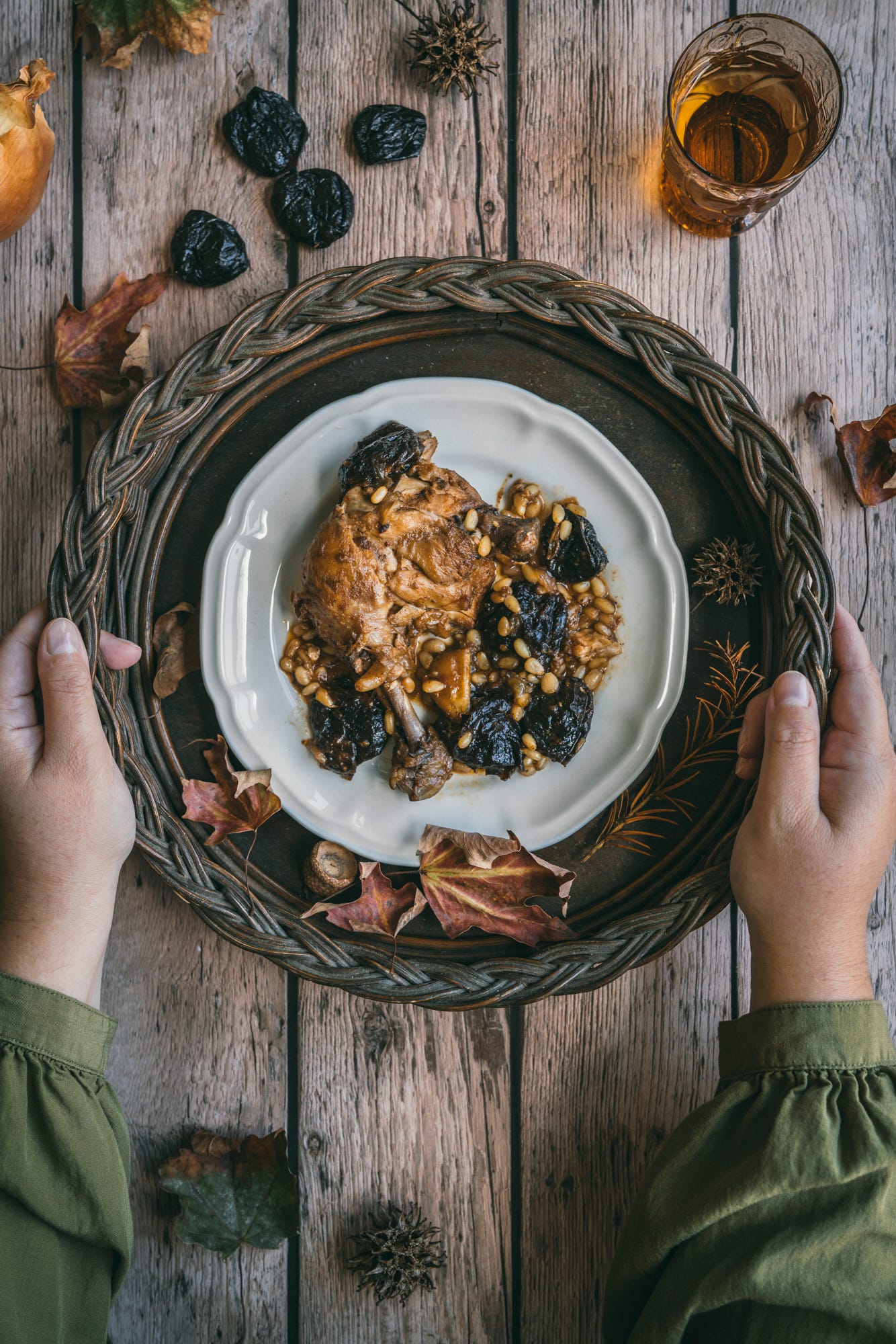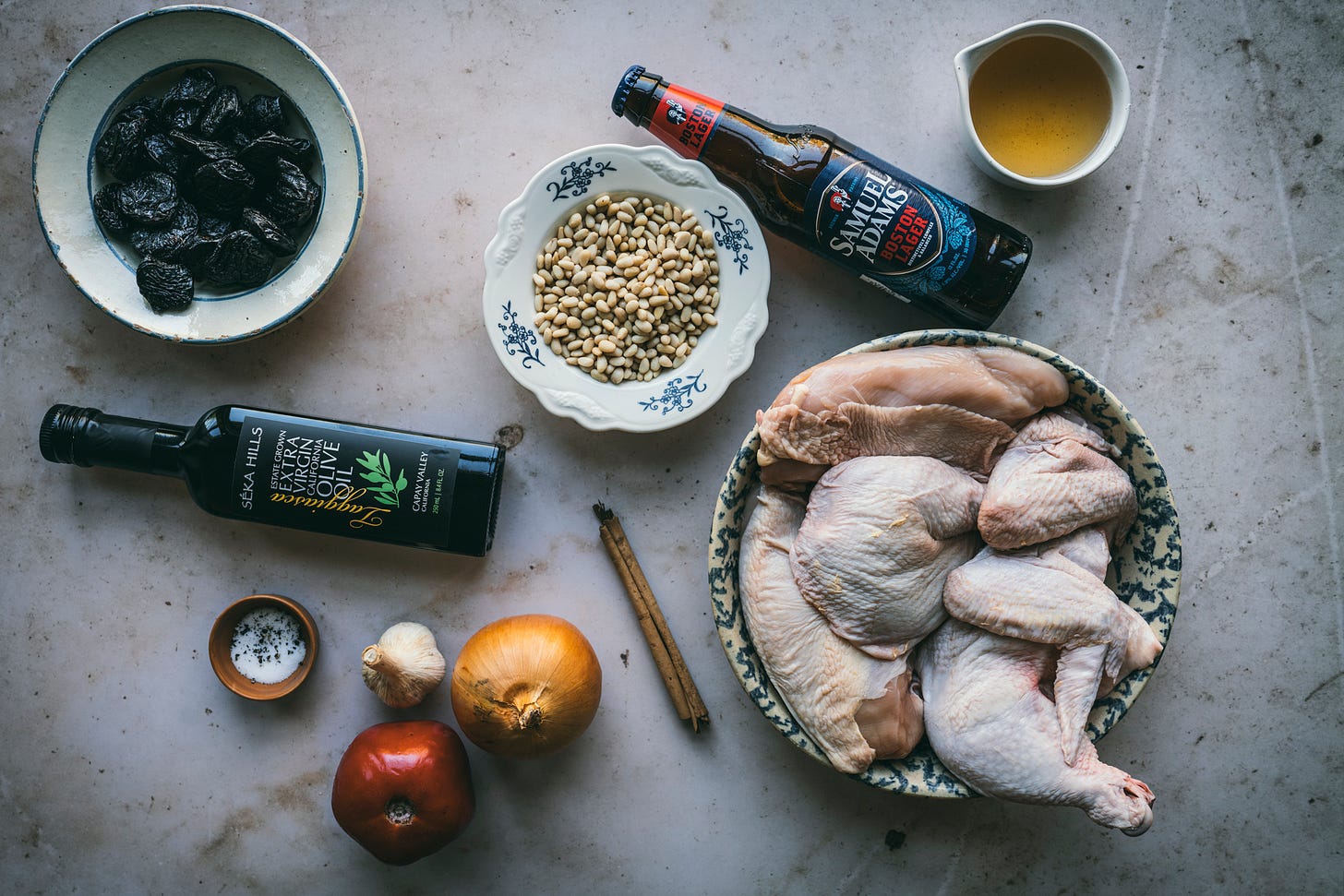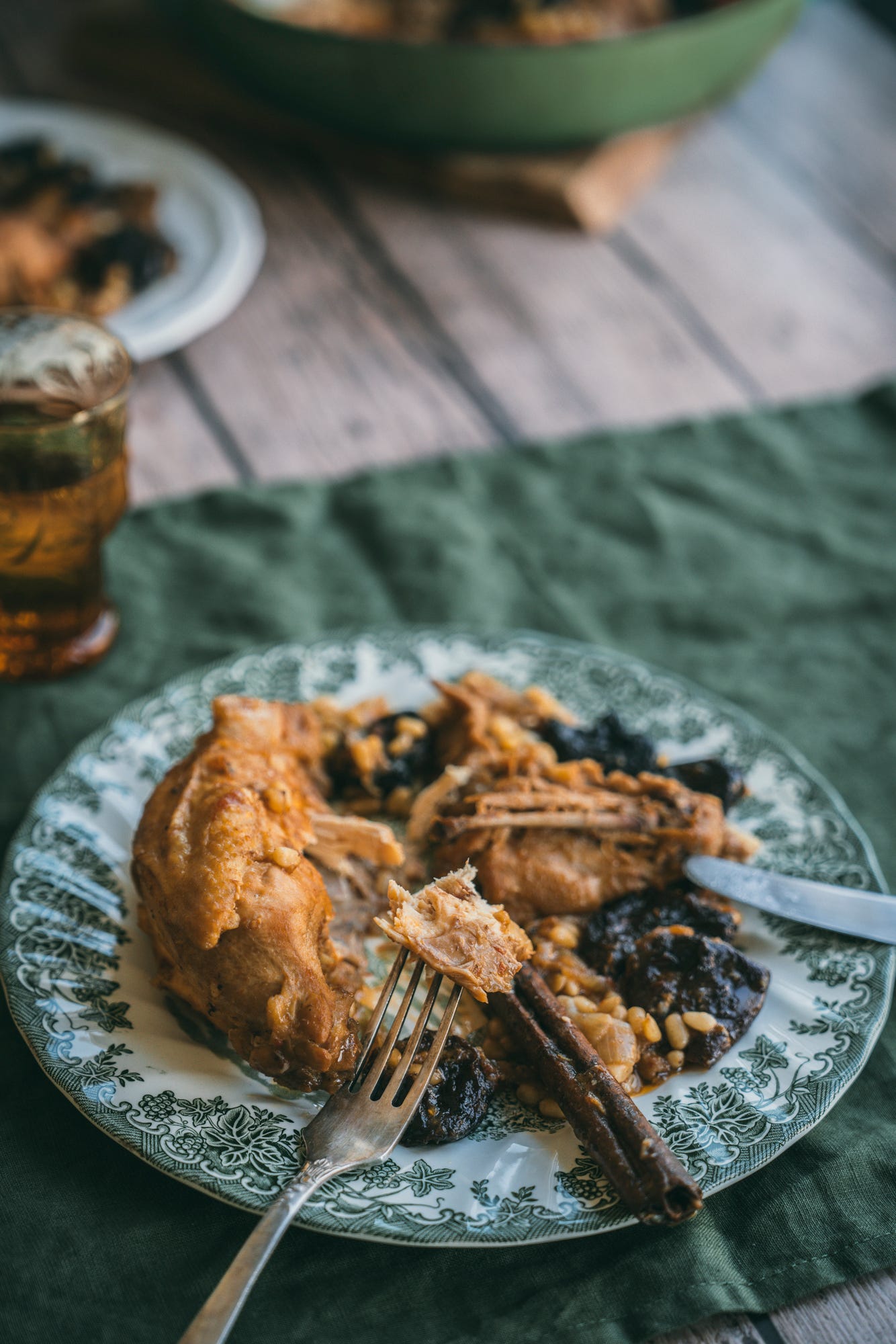Pollastre Rostit amb Prunes i Pinyons
A festive Catalan recipe of braised chicken with prunes and pine nuts
This is a dish many Catalans associate with Christmas and the holiday season, but I wanted to share it weeks before that in case some of you would like to try it for Thanksgiving as an alternative to turkey.
Traditionally in Catalonia chicken were raised to be sold and only eaten for very important occasions. It was truly un plato de postín, an upmarket meal. To cook a chicken for the family meant not monetising it. The prunes, pine nuts and cinnamon also remind of winter and of Medieval times when it was common to add sweet notes to savoury dishes.
In Catalan rostir doesn’t really mean “to roast”, which may be confusing; but to cook meat in a casserole with fat. The closest would be “to braise”, as normally added liquid is also poured to help speed the cooking. Roasting, in English, refers “to cook by exposing to dry heat (as in an oven or before a fire) or by surrounding with hot embers, sand, or stones”, which in Catalan we divide into “to cook in the oven” (cuinar al forn), “to cook on embers” (cuinar a la brasa), “to cook on a skewer” (cuinar a l’ast), etc.
In the 18th century a Franciscan priest already mentions the term “a Catalan roast” to refer to this technique in his cookbook Avisos i instructions per lo principiant cuiner:
“Place the poultry on the fire with a good piece of bacon and water to cover halfway up the poultry, or lamb legs. Add salt, let it boil, turning the meat very so often. When it’s cooked through, turn the heat up so the liquid reduces. Finally, if you like, add a bit of white wine and spices, but it’s not necessary, because on low heat the meat will brown as much as you like […]” — My translation

The recipe I bring you today doesn’t differ that much from the 18th century one. To start, you’ll need a cassola or braiser, one big enough to hold all the chicken pieces. It needs to sit on top of your stove, on an open flame, so make sure that it’s not an only-oven vessel. You’ll also need some lard, as my aunt says it makes the meal more “loving”.
I called my aunt Teresa, my father’s sister, who is a great cook, to confirm the ingredients with her. Most recipes call for brandy or aged wine (vi ranci) but I didn’t remember my family cooking it this way.
“La iaia always used to make it with beer, so it is is how we make it at home as well; it turns out delicious!”. I would never dare to contradict my grandma and curiously, checking with my aunt Montse, from the other side of the family, she said that’s how she makes it as well. Grandma check and aunt restaurant-owner double check.
I actually loved the idea of using beer to flavour the braise as Boston is famous for its beers! I didn’t even had to search far!
So this is a Catalan recipe with Medieval notes and classic techniques that is very attainable, and you won’t even need to buy special booze to make it! It’s also a great option for the holidays because it actually tastes better the day after making it, which means less cooking on the special day and more hosting!
Some tips
In Catalonia most people try to buy a pollastre de pagès for this recipe. It literally translates to “farmer’s chicken” and it refers to chicken that are bigger and tastier as they have been raised free-range. I always try to buy free-range chicken nonetheless for ethical reasons, but in this occasion it will also make your meal more regal and substantial. I bought mine from my local farmer’s market and got the pieces already cut, but if you have butchery skills, you can go ahead and buy a whole chicken!
It’s adviced to rub your chicken pieces in salt some hours before cooking it. The salt will permeate the meat and it will flavor it from within while making it more tender. If you are going to cook the dish in the afternoon, salt the chicken in the morning. If you are going to make it in the morning, you can salt it the night before and keep in in the fridge.
As I mentioned, it’s recommended to use olive oil and also lard for this recipe. Traditionally it would have been cooked in lard alone (as my translation of the 18th century recipe shows) but a mix works great. I must confess I couldn’t find lard close by to where I live so I used a short cut. I bought some bacon and reserved the fat after cooking it. I filtered it twice and that’s what I used. You can do the same or buy lard directly if you think you’ll use it for more recipes.
One more note on that, once you’ve browned your chicken in the olive oil-lard, you’ll need to remove the excess of oil before cooking the vegetables. Don’t throw that away! It has an amazing flavor and you can use it to make other preparations. In Catalonia is very common to make macarrons (pasta with ground meat) with it afterwards. Maybe a future recipe if you are interested?
For the vegetables, traditionally you don’t peel the tomato or the garlic bulb. With the cooking it all disintegrates and the flavors build up together. Now, I found myself fishing the tomato and garlic peels before serving it; so if that would bother you, you can peel the tomato and the outer peels of the garlic before adding them to the braiser.
Some people also add orellanes (dried apricots), so feel free to swap some prunes for those if you like the flavor.
Last but not least, you want to reduce the liquid completely so there’s only oil left in the end. We are making a Catalan roast not a stew!
Ingredients
1 chicken, cut in eighths
1 tomato, cut in quarters
1 onion, peeled and cut in quarters
1 bulb of garlic, whole
1 branch of cinnamon
1 beer
3 1/3 tbsp (50 ml), olive oil
3 1/3 tbsp (50 ml), lard
3.5 oz (100 g) pine nuts
7 oz (200 g) prunes
Salt and pepper, to taste + extra to salt the chicken
Instructions
Cooking time: 1 1/2 hour
Servings: 4
Rub the chicken with salt the morning of or the night before. If you bought it whole, you can also butcher it now. Keep refrigerated.
Coat a big pan or braiser with the olive oil and lard and stir-fry the chicken on both sides until they are golden in color. Add more oil or lard if you need, the chicken needs to be half-coated. Set aside.
Remove the excess of oil keeping it in a different container. Don’t throw it away, it’s really good to use in other preparations.
In the same braiser, add the tomato, onion and garlic and turn the heat down. Put the lid on and let soften for 15 minutes. Add the cinnamon branch and mix again.
When the vegetables have soften and changed color, add the chicken back in the braiser.
Pour the beer and turn the heat up a bit to help evaporate.
Mix making sure the chicken is coated. Turn the heat down, put the lid back on and let cook for 50 minutes. Check halfway and if the liquid dries up, add some water.
Add the pine nuts and the prunes and mix again. Lift the lid and cook uncovered for another 10-15 minutes until there’s almost no liquid left.
Serve immediately or let rest for the next day.
¡Bon profit!











I love this everything about this dish. I am big fan of the Catalan dried fruit, pinyons, and spices flavor profile. And I also love the very good description of this cooking technique, half braised/half confit, which I also do when cooking a whole duckling and other poultry. Now I can credit my neighboring Catalans! Thank you for sharing this, Elisabet!
This looks great! And love that you saved the rendered bacon fat. We save ours in a mason jar every time we cook bacon, and we go through a lot of it!